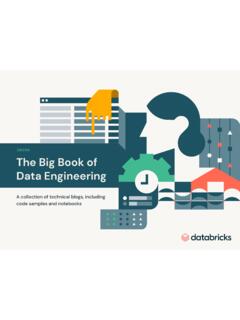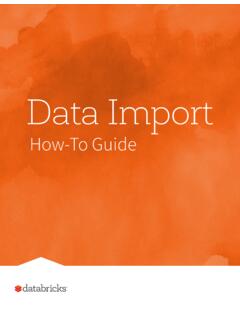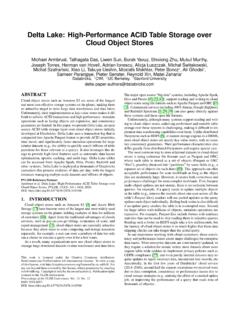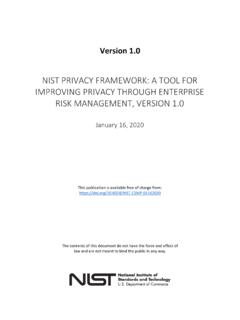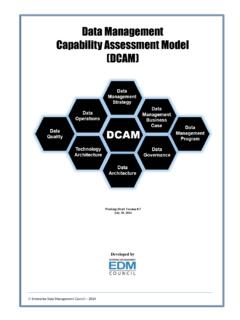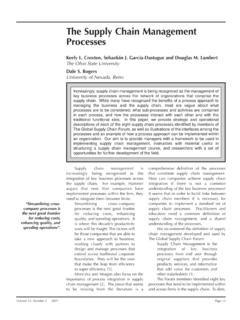Transcription of eBook Data Management 101 on Databricks
1 data Management 101 on DatabricksLearn how Databricks streamlines the data Management lifecycleeBookGiven the changing work environment, with more remote workers and new channels, we are seeing greater importance placed on data Management . According to Gartner, The shift from centralized to distributed working requires organizations to make data , and data Management capabilities, available more rapidly and in more places than ever before. data Management has been a common practice across industries for many years, although not all organizations have used the term the same way. At Databricks , we view data Management as all disciplines related to managing data as a strategic and valuable resource, which includes collecting data , processing data , governing data , sharing data , analyzing it and doing this all in a cost-efficient, effective and reliable : data Management 101 ON DATABRICKSI ntroduction 2 The challenges of data Management 4 data Management on Databricks 6 data ingestion 7 data transformation.
2 Quality and processing 10 data analytics 13 data governance 15 data sharing 17 Conclusion 19 Contents3 eBook : data Management 101 ON DATABRICKSU ltimately, the consistent and reliable flow of data across people, teams and business functions is crucial to an organization s survival and ability to innovate. And while we are seeing companies realize the value of their data through data -driven product decisions, more collaboration or rapid movement into new channels most businesses struggle to manage and leverage data correctly.
3 According to Forrester, up to 73% of company data goes unused for analytics and decision-making, a metric that is costing businesses their vast majority of company data today flows into a data lake, where teams do data prep and validation in order to serve downstream data science and machine learning initiatives. At the same time, a huge amount of data is transformed and sent to many different downstream data warehouses for business intelligence (BI), because traditional data lakes are too slow and unreliable for BI on the workload, data sometimes also needs to be moved out of the data warehouse back to the data lake. And increasingly, machine learning workloads are also reading and writing to data warehouses. The underlying reason why this kind of data Management is challenging is that there are inherent differences between data lakes and data challenges of data managementDataSharingDataManagementDataG overnanceDataAnalyticsData Transformation and ProcessingData Ingestion4 eBook : data Management 101 ON DATABRICKSOn one hand, data lakes do a great job supporting machine learning they have open formats and a big ecosystem but they have poor support for business intelligence and suffer from complex data quality problems.
4 On the other hand, we have data warehouses that are great for BI applications, but they have limited support for machine learning workloads, and they are proprietary systems with only a SQL : data Management 101 ON DATABRICKSU nifying these systems can be transformational in how we think about data . And the Databricks Lakehouse Platform does just that unifies all these disparate workloads, teams and data , and provides an end-to-end data Management solution for all phases of the data Management lifecycle. And with Delta Lake bringing reliability, performance and security to a data lake and forming the foundation of a lakehouse data engineers can avoid these architecture challenges. Let s take a look at the phases of data Management on Management on DatabricksLearn more about the Databricks Lakehouse Platform Learn more about Delta Lake 6 eBook : data Management 101 ON DATABRICKSIn today s world, IT organizations are inundated with data siloed across various on-premises application systems, databases, data warehouses and SaaS applications.
5 This fragmentation makes it difficult to support new use cases for analytics or machine learning. To support these new use cases and the growing volume and complexity of data , many IT teams are now looking to centralize all their data with a lakehouse architecture built on top of Delta Lake, an open format storage layer. However, the biggest challenge data engineers face in supporting the lakehouse architecture is efficiently moving data from various systems into their lakehouse. Databricks offers two ways to easily ingest data into the lakehouse: through a network of data ingestion partners or by easily ingesting data into Delta Lake with Auto ingestion7 eBook : data Management 101 ON DATABRICKSThe network of data ingestion partners makes it possible to move data from various siloed systems into the lake. The partners have built native integrations with Databricks to ingest and store data in Delta Lake, making data easily accessible for data teams to work : data Management 101 ON DATABRICKSOn the other hand, many IT organizations have been using cloud storage, such as AWS S3, Microsoft Azure data Lake Storage or Google Cloud Storage, and have implemented methods to ingest data from various systems.
6 Databricks Auto Loader optimizes file sources, infers schema and incrementally processes new data as it lands in a cloud store with exactly once guarantees, low cost, low latency and minimal DevOps work. With Auto Loader, data engineers provide a source directory path and start the ingestion job. The new structured streaming source, called cloudFiles, will automatically set up file notification services that subscribe file events from the input directory and process new files as they arrive, with the option of also processing existing files in that all the data into the lakehouse is critical to unify machine learning and analytics. With Databricks Auto Loader and our extensive partner integration capabilities, data engineering teams can efficiently move any data type to the data moreData ingestion on Databricks9 eBook : data Management 101 ON DATABRICKSM oving data into the lakehouse solves one of the data Management challenges, but in order to make data usable by data analysts or data scientists, data must also be transformed into a clean, reliable source.
7 This is an important step, as outdated or unreliable data can lead to mistakes, inaccuracies or distrust of the insights engineers have the difficult and laborious task of cleansing complex, diverse data and transforming it into a format fit for analysis, reporting or machine learning. This requires the data engineer to know the ins and outs of the data infrastructure platform, and requires the building of complex queries (transformations) in various languages, stitching together queries for production. For many organizations, this complexity in the data Management phase limits their ability for downstream analysis, data science and machine transformation, quality and processing10 eBook : data Management 101 ON DATABRICKSTo help eliminate the complexity, Databricks Delta Live Tables (DLT) gives data engineering teams a massively scalable ETL framework to build declarative data pipelines in SQL or Python. With DLT, data engineers can apply in-line data quality parameters to manage governance and compliance with deep visibility into data pipeline operations on a fully managed and secure lakehouse platform across multiple : data Management 101 ON DATABRICKSDLT provides a simple way of creating, standardizing and maintaining ETL.
8 DLT data pipelines automatically adapt to changes in the data , code or environment, allowing data engineers to focus on developing, validating and testing data that is being transformed. To deliver trusted data , data engineers define rules about the expected quality of data within the data pipeline. DLT enables teams to analyze and monitor data quality continuously to reduce the spread of incorrect and inconsistent data . Delta Live Tables has helped our teams save time and effort in managing data at this capability augmenting the existing lakehouse architecture, Databricks is disrupting the ETL and data warehouse markets, which is important for companies like ours. Dan Jeavons, General Manager, data Science, ShellA key aspect of successful data engineering implementation is having engineers focus on developing and testing ETL and spending less time on building out infrastructure. Delta Live Tables abstracts the underlying data pipeline definition from the pipeline execution.
9 This means at pipeline execution, DLT optimizes the pipeline, automatically builds the execution graph for the underlying data pipeline queries, manages the infrastructure with dynamic resourcing and provides a visual graph for end-to-end pipeline visibility on overall pipeline health for performance, latency, quality and all these DLT components in place, data engineers can focus solely on transforming, cleansing and delivering quality data for machine learning and moreData transformation on Databricks with Delta Live Tables12 eBook : data Management 101 ON DATABRICKSNow that data is available for consumption, data analysts can derive insights to drive business decisions. Typically, to access well-conformed data within a data lake, an analyst would need to leverage Apache Spark or use a developer interface to access data . To simplify access and query a lakehouse, Databricks SQL allows data analysts to perform deeper analysis with a SQL-native experience to run BI and SQL workloads on a multicloud lakehouse architecture.
10 Databricks SQL complements existing BI tools with a SQL-native interface that allows data analysts and data scientists to query data lake data directly within dedicated SQL workspace brings familiarity for data analysts to run ad hoc queries on the lakehouse, create rich visualizations to explore queries from a different perspective and organize those visualizations into drag-and-drop dashboards, which can be shared with stakeholders across the organization. Within the workspace, analysts can explore schema, save queries as snippets for reuse and schedule queries for automatic analytics13 eBook : data Management 101 ON DATABRICKSC ustomers can maximize existing investments by connecting their preferred BI tools to their lakehouse with Databricks SQL Endpoints. Re-engineered and optimized connectors ensure fast performance, low latency and high user concurrency to your data lake. This means that analysts can use the best tool for the job on one single source of truth for your data while minimizing more ETL and data silos.
